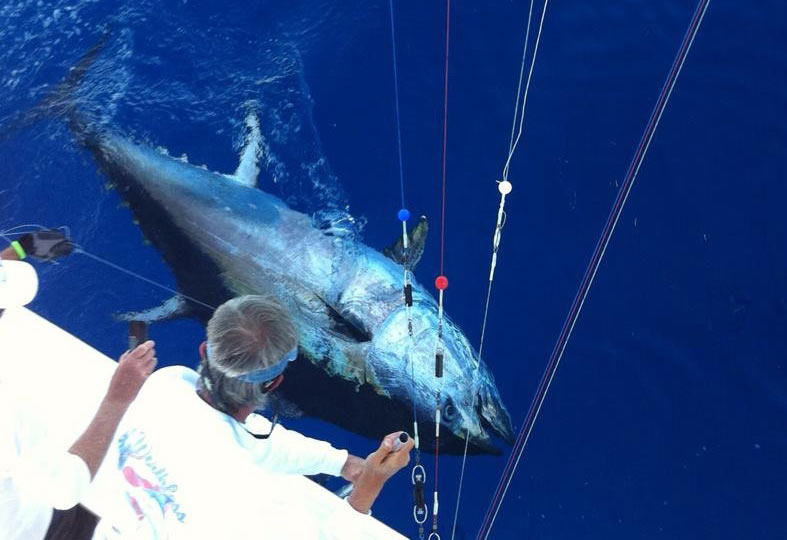With very little exception, the warm-blooded fishes are all fast-swimming, blue-water predators or species that dive to catch prey. Also, there are similar heat exchange systems in other parts of the bodies of some predatory fish, such as the brains and eyes of swordfish, shortfin makos, and porbeagle sharks. Scientific research is concluding that these circulatory system adaptations of these predators grant them an advantage over their prey. For instance, warmed swimming contract faster, allowing the tuna to have greater swimming thrust than its prey. Warm eyes and brains are great advantages to species like swordfish, which must dive through great depths of cold water. Clear vision is important to billfish as well, so it helps that their eyes stay warm when hunting. The next time you hook a tuna or a billfish, take a moment to appreciate what an efficient warm-blooded killer Mother Nature has designed.
More Tuna Related Articles
The Tuna Wrap- Top Crews’ in Top Tuna Hot Spots Click Here
All Tackle Pacific Bluefin Record Click Here

From a young age, we were all taught that animals generally fall into two categories: warm-blooded and cold-blooded. Personalities are often associated with these groups, hence phrases like cold-blooded killer. We were also taught that fish, snakes, turtles and frogs are all examples of cold-blooded animals. However, in some of our most prized game-fish species, the opposite is true. The difference between a warm-blooded (endothermic) animal and a cold-blooded (endothermic) animal is its ability to maintain its body temperature. What this means is that warm-blooded animals can maintain a constant body temperature despite the external temperature of their environment. Humans fall into this category along with all other mammals and birds. The body temperature of cold-blooded animals is controlled by the temperature of their environment.
Warm-Blooded Killers
Fishery scientists consider many species of large predatory game fish to be warm-blooded. These species include tuna, mako and great white sharks, and marlins. But what makes these fish so different from all the others? The actual physical structure of their circulatory systems is dramatically different from other fish. Their blood vessels have a counter-current exchange system and a structure called a retia mirabilia, which literally means wonderful net. Imagine the closed circulatory system of a tuna. As the tuna swims, heat is produced as a byproduct of active muscles. The muscles used for swimming are rich in blood vessels that provide oxygen to the muscles as they rapidly move. The heat given off by all this activity in most fishes is lost as the blood moves throughout the body, especially near the skin surface, which is much cooler than the muscle because of its close contact with the colder ocean water. But in tuna and other warm-blooded fish, the heat carried within the blood as it passes through active muscle tissue is not lost. As these vessels leave the muscle layers, they pass through the retia mirabilia, which is similar to a honeycomb of blood vessels. Other blood vessels, returning from colder areas of the body, such as the skin, also pass through this retia mirabilia. As the cooler and warmer blood vessels pass through this structure, they are brought so close together that the blood heat from the warmer areas exchanges with the colder blood across the walls of the blood vessels. These warm-blooded fish are not considered to be truly warm-blooded as mammals, because they cannot maintain a constant body temperature. However, the countercurrent exchange of the body heat produced in the swimming muscles is so efficient that the fish cannot be considered truly cold-blooded either. For example, in skipjack tuna, 95% of the heat produced in the swimming muscles is conserved. A grouper can only keep its body temperature about 0.3 degrees Celsius above its surrounding water temperature, while an albacore tuna can raise its body temperature to about 12 degrees Celsius above its surrounding water temperature.
Why Are They Warm-Blooded?
With very little exception, the warm-blooded fishes are all fast-swimming, blue-water predators or species that dive to catch prey. Also, there are similar heat exchange systems in other parts of the bodies of some predatory fish, such as the brains and eyes of swordfish, shortfin makos, and porbeagle sharks. Scientific research is concluding that these circulatory system adaptations of these predators grant them an advantage over their prey. For instance, warmed swimming contract faster, allowing the tuna to have greater swimming thrust than its prey. Warm eyes and brains are great advantages to species like swordfish, which must dive through great depths of cold water. Clear vision is important to billfish as well, so it helps that their eyes stay warm when hunting. The next time you hook a tuna or a billfish, take a moment to appreciate what an efficient warm-blooded killer Mother Nature has designed.













